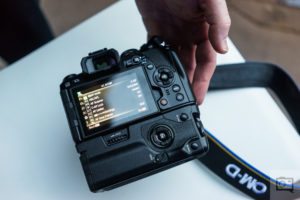
You never forget your first camera. Mine was a Miranda Automex III which, despite not being fully functional, sparked my interest in photography and I’ve been hooked ever since. If you’re looking to take your first steps up the photography ladder, you’ve come to the right place.
Today’s market offers a wide selection of models, plus there’s the additional decision of picking between a digital SLR and a mirrorless camera. If compact size and light weight are important considerations for you, mirrorless is the more favourable choice and that’s what the five models we’ve pulled together here have a common - no internal mirror. Which one of this quintet is best for you? Well, that will be down to personal choice, but every one of these cameras offers a great range of functions at an attractive price. Let’s have a look at each one in more detail.
If you like a retro look, you're going to love the Fujifilm X-T100
Fujifilm X-T100
Fujifilm’s X Series cameras have proved popular thanks to their blend of the latest technologies wrapped in a traditional looking body and the X-T100 is no exception. From the front and top it looks like an old SLR with a pentaprism housing a 2. 36 million dot electronic viewfinder and top-plate dials accessing key functions, but don’t let this deceive you - there are plenty of the latest goodies packed inside. These include a 24. 2 megapixel CMOS sensor, touchscreen rear LCD, 4K video capability and wireless connectivity through either Wi-Fi or Bluetooth.
An easy-accessed Auto mode makes it simple to use the X-T100 as a point-and-shoot camera, but there are all the other features you need to advance your photographic skills and knowledge. There’s an excellent range of lens options, too.
Complact and light perhaps, but the GX80 is still full of useful features
Panasonic Lumix GX80
The Lumix GX80 has a rangefinder-style design with the 2. 76 million dot electronic viewfinder offset to one side of the camera. Portrait photographers will tell you that this layout helps maintain a better rapport with your subject as less of your face is hidden behind the camera - worth considering if you’re going to be taking a lot of people pictures.
Resolution runs to 16 megapixels, plus you can shoot 4K video and there’s 5-axis image stabilisation built into the camera, which is great for keeping camera shake under control. The Post Focus function is also worthy of note, which allows you to choose the point of focus in your image after it has been taken! Plenty of lens options are available for the GX80’s Micro Four Thirds lens mount and, at just 426g, the Panasonic is light on your shoulder as well as your pocket.
If you want to shoot action, the Canon EOS M50 could be the right model for you
Canon EOS M50
Canon has been grabbing the headlines recently with its full-frame mirrorless models - the EOS R and RP - but the company’s M series of models are well worthy of consideration with this DSLR-style camera offering a wealth of tempting features. The M50 boasts a 24. 1 megapixel sensor that’s linked to Canon’s latest DIGIC 8 processor for a powerful performance, including the capability to capture 4K video and shoot continuously at 10 frames-per-second. Wi-Fi and Bluetooth are both available for easy wireless connectivity making it simple to share images on social media or blogs within seconds of shooting.
Admittedly, the M Series lens range is a little more limited than other cameras here, but if you opt for the optional EF-EOS M adapter you can attached any Canon EF or EF-S lens, which opens up an enormous selection.
The A5100's screen flip to 180°, which is useful if you like to shoot selfies
Sony A5100
For many, Sony leads the way when it comes to mirrorless cameras and this budget model certainly has a good range of features to take on its competitors. One thing it doesn’t have, however, is a viewfinder so composing is done in the rear LCD, which flips up to 180° - handy if you like to take selfies.
Internally, there’s a 24. 3 megapixel sensor linked to Sony’s proven BIONZ X processor, plus users can select from 179 different focusing points spread over most of the frame - or leave the camera to make the choice, of course. If you want to shoot video, the A5100 captures Full HD footage - there’s no 4K here - but it does have touchscreen control so you can touch the area you want in focus during filming. Wi-Fi and NFC wireless connection options make it simple to share your efforts and there’s a great range of lenses available for the camera’s E lens mount.
A selection of Art Filters on the E-PL9 deliver eye-catching effects in camera
Olympus PEN E-PL9
Like the Sony A5100, this is another model that doesn’t offer a viewfinder, but does have a touchscreen rear LCD that flips downwards so you can easily capture selfie shots. Wi-Fi and Bluetooth provide simple wireless connectivity while a dedicated smartphone app (OI. Share) features a useful Camera How to section that will help you get to grips with the camera.
The E-PL9 uses a Micro Four-Thirds sensor with a 16. 1 megapixel resolution, plus camera shake is kept under control by the 3-axis image stabiliser that’s built into the body. A wide range of Art Filters allow you to get eye-catching effects in camera without needing a computer, while 121 focusing points give an accurate focusing performance. There’s also a healthy range of lens options that will help you tackle a wide range of subjects.
. digitalrev.com2019-3-7 03:00













